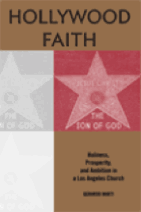PART I: African American Integration into Diverse Churches
The lead article is one I originally wrote about two years ago, which went through two sets of revisions with very extensive, and very helpful, comments by other scholars:

Journal for the Scientific Study of Religion, Volume 49 Issue 2 (June 2010)
The unique history of African Americans in the United States fuels much of the discussion on the relationship between religion and race in diverse congregations. The impetus for much of the current research on multiracial churches began with Emerson and Smith's bestselling book Divided by Faith (2000), an overall pessimistic assessment of the potential for black-white integration within American Protestant Christianity.
The article distinguishes "Ethnic Reinforcement" from "Ethnic Transcendence," processes that are believed to be necessary for achieving racial integration of distinct ethnic-racial groups. However, these are often seen as contradictory. So the article asks weighs one versus the other and asks if one is more important than the other. Or perhaps there is a more nuanced interaction between the two?

You'll find much more information (including background, quotes, references, and explanations). The article greatly expands ideas first found in A Mosaic of Believers and then touched in the "race" parts of my book Hollywood Faith. Here's a bit from the conclusion:
I find that the intentional focus on diversity and programs of churches do promote intergroup contact to foster an "inclusive identity" that indicate processes of ethnic transcendence (as I describe in earlier articles also published in JSSR in 2008 and 2009). At the same time, African-American members in the church I studied recognize and appreciate the markers that affirm a distinctive African-American experience. In other words, "ethnic reinforcement" is achieved in the church by recognizing blacks up front in lay and staff roles, by race-specific practices in church life (e.g., musical styles), and by preaching racial awareness from the pulpit.
The distinctives of the African-American experience in white-dominant American society appears to require multiracial congregations to construct relational havens in such a way that blacks are affirmed, protected, and perhaps even entertained. Such racial affirmation is good enough for most blacks, yet the church does not appeal equally to all. For other African Americans, the church is "not black enough," and this failure to adequately incorporate a much higher degree of black prominence (which further indicates the importance of ethnic reinforcement). So, while other studies have argued for the importance of mixing musical and preaching styles as well as providing an awareness of racial issues from the pulpit to keep a multiracial congregation together, this case study suggests that the exceptionalism of African Americans plays itself out in the interaction between reinforcement and transcendent and prompts a closer understanding of the importance of these practices.
In achieving diversity, the congregation does not merely invoke ethnic reinforcement; rather, the congregation places the value of diversity at the center of the congregation in a way that recognizes the unique experience of African Americans.
PART II: Scholars Response to My Approach to Understanding Diversity
Well, the article almost didn't get published. One reviewer very much disagreed with my approach and made several insightful comments. The editor decided to put the article forward, inviting the scholar to print his objections, and allow me to respond.
This led to an exchange. My reply is found here:

Journal for the Scientific Study of Religion, Volume 49 Issue 2 (June 2010)
In my reply article, I urge caution for scholars who have not studied particular cases to not base critiques in supposed "ideal" situations:"Ethnographers take a risk whenever they select a case for study. We immerse ourselves among people in the hope of yielding significant findings, yet none of us can predict the outcome of our research. The commitment of time, energy, and professional status is enormous, but ultimately we cannot tell ahead of time the exact dynamics in play or the manner of their operation. It reminds me of the "mystery bag" game we played as children. Each of us would reach into a large sack without knowing what was inside and try to guess the contents based on the touch of our hands. Ethnographic sites are mystery bags; researchers have some sense that there is indeed 'something' to be found but cannot entirely be sure what it is until a much greater degree of access, observation, and interpretation is achieved."In writing a long response -- I'll encourage you to read it yourself as it deals with several current issues in the study of congregational diversity -- I talked about how to move the study of diverse congregations forward.
For example, we should isolate significant arenas of diversification and investigate contemporary initiatives for diversification. Michael Emerson recently suggested that megachurches are diversifying more quickly than other congregations. Such an observation is provocative and potentially important, but we lack the systematic research to state this more confidently. Can we identify processes of diversification that differ by the size of congregations?
I would also agree with Michael that there is great enthusiasm among church leaders to catalyze and sustain diversification. New conferences and pastoral networks as well as new publications and program initiatives are aggressively advocating diversity as a missional cause. Research is required to identify the nature and scope of this broad movement. I suspect that rigorous research will identify intriguing ironies and contradictions, and I expect to articulate some of them through my own research on music and worship in successfully diverse churches
In the end, this was a very fruitful exchange. Scholars wrestling with ideas and sharpening each other's work. I hope this one gets the attention it deserves and accelerates a much-needed sophistication on these issues.




No comments:
Post a Comment